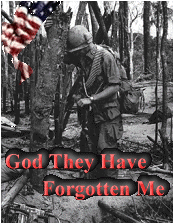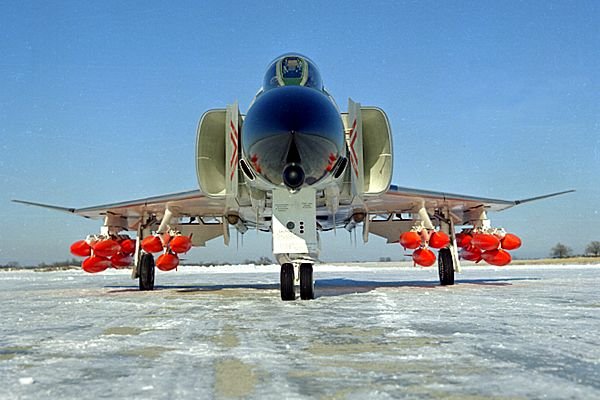
![]()
 |
A hero he has fallen
In a far off lonely land
A place that we believed in
A place called Viet Nam...
MIA
Some disappeared in a field of mud,
Others by shellfire - a mist of blood,
Some fell to earth on a trail of smoke,
But some are still lost and yet our hope Lives on;
and by our lives,
We will not forget the look in their eyes,
Nor the Holy glimmer of last Good-Byes...
![]()


This is the POW/MIA bracelet that I have worn since 1967
![]()
|
BUSCH, JON THOMAS Remains returned 13 July 1988 - ID'D October 1988 |
| Name: Jon Thomas Busch
Rank/Branch: O2/USAF Unit: 398th Tactical Fighter Squadron, Da Nang, South Vietnam Date of Birth: May 7, 1941 Home City of Record: Columbus OH Date of Loss: 08 June 1967 Country of Loss: North Vietnam Loss Coordinates: 173900N 1061600E (XE343517) Status (in 1973): Missing In Action Category: 2 Acft/Vehicle/Ground: F4C |
|
Other Personnel in Incident: Victor J. Apodaca, Jr. |
| Source: Compiled by Homecoming II Project 30 June 1990 from one or more of the following: raw data from U.S. Government agency sources, correspondence with POW/MIA families, published sources, interviews. |
| SYNOPSIS: On the evening of June 8, 1967, two F4C Phantom planes departed
Da Nang Airbase on an armed reconnaissance mission over North Vietnam.
Hambone 1 took the lead, followed about a mile behind by Hambone 2, commanded
by Capt. Victor Apodaca, Jr. and flown by Capt. Jon T. Busch. The two aircraft
were flying at an altitude of about 4500 feet over a river valley with
rolling to mountainous terrain about 22 miles northeast of Dong Hoi, North
Vietnam.
Hambone 1 radioed Hambone 2 that he was encountering heavy and accurate ground fire. Fifteen seconds later, Apodaca acknowledged the warning and reported that his aircraft had been hit. Hambone 1 advised Apodaca to exit the area and head for the coast (where a safer at-sea rescue could occur). Moments later, Hambone 2 reported that it was experiencing control and hydraulics problems. The last message from Hambone 2 gave the direction of the aircraft and its altitude, which was 16,000 feet. Seconds later, emergency signals were received for about 25 seconds, but it was not possible to determine whether one or two radio signals were broadcasting, nor could the precise point of origination be determined. Hambone 1, critically low on fuel, was forced to return to base. An electronic search was conducted, but suspended due to darkness, bad weather and heavy anti-aircraft fire. During the search, no electronic or visual contact was made and no evidence of the aircraft was found. The Air Force told the families they could not determine whether or not the men survived. Neither man was among the prisoners released in 1973 from Vietnam, and the Hanoi government denies any knowledge of them for 20 years. On November 12, 1973, a refugee reported the death of an American airman which occurred in Bo Trach District, Quang Binh Province, North Vietnam at about 1500 hours one day in June 1967. According to the report, a U.S. F4 jet flying with about five other jets bombing a bridge on Route 1A was hit by 37mm anti-aircraft fire, crashed into Doi Troc Hill in Chanh Hoa II village. The source further stated that an airman bailed out and landed in a forest near the same village. At about 1530 hours, the refugee went to where the airman landed and saw his body lying in the grass. He was told by villagers that approximately 10 minutes after the airman had landed, militiamen from the village found him hiding in a bamboo thicket and captured him. The villagers then watched as the militiamen beat the American to death with hoes and bamboo sticks. The refugee said he observed the dead American for about 10 minutes from a distance of about 5 meters. He described the airman as a caucasian, about 45 years old, 5' 11" tall, weighing about 220 pounds with fair complexion, short blonde hair, a moustache about one centimeter long and a heavy beard. He was unable to identify the airman from photos of the missing. JCRC correlated the report to the Busch/Apodaca incident. In the spring of 1988, remains identified as Jon Busch, a burned map, three pieces of bone (which were identified as non-human by a Vietnamese anthropologist) and a charred and battered nameplate bearing Apodaca's name were returned to Presidential Envoy General John Vessey. Busch's remains were positively identified by the U.S. Army Central Identification Laboratory in Hawaii, based largely on the correlation of the refugee report, which evidently matched information given over by the Vietnamese with the remains. The status of "Box 19", which purportedly hold the effects of Victor Apodaca Jr, are still unknown to his family. There are serious discrepancies in the refugee report as it relates to Busch and Apodaca. Jon Busch has red hair, not blonde. Vic Apodaca has black hair. Both men were clean shaven, and were forbidden by the Air Force to grow a beard. The Hambone flight departed at 5 p.m. in the evening, while the CIA report claimed the airman was killed at 3:30 p.m. just following his landing. The Hambone flight, while armed, was not involved in a bombing mission at all. Jon Busch was declared dead in 1967. Victor Apodaca was declared dead three days after the CIA received the refugee report. The Apodaca family was never given the report by the U.S. Government. They discovered the report through a Freedom of Information Act request they filed in 1985. To many observers, there is a serious problem with the identification of these remains. Many will retain Jon Busch on the lists of missing because the discrepancies are too outrageous to make the correlation possible. Jon Busch and Vic Apodaca are two of nearly 2500 Americans who were declared missing in Southeast Asia. Thousands of reports add to the evidence that perhaps hundreds of them are still held prisoner of war. Perhaps Jon and Vic died on the day of the crash of their aircraft. But, perhaps they did not. If the remains returned are not Jon Busch's, who will be looking for him? Not the U.S. Government. His case is officially closed. Vic Apodaca's family wants the truth. His sister Dolores says, "I won't just let them bury his memory based on some report with that many discrepancies. It's been 22 years, but none of us are so tired that we'll drop this without a fight." Victor Joe Apodaca, Jr. was appointed to the Air Force Academy in 1957. He was the first Spanish/American/Navajo Indian to attend the Academy. |
 |
The F4
Click on bracelet if you would like to make a difference.
The song playing is " Live To Tell"

This Operation Just Cause Web Ring site is owned by
Donna Schellack |